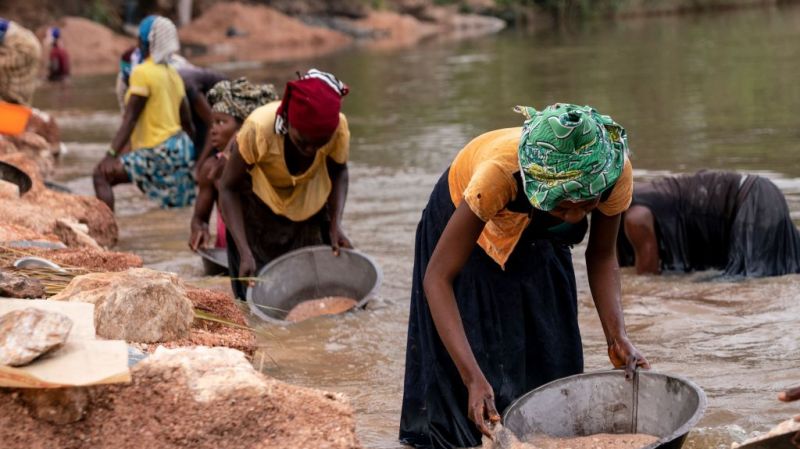Empowering Women in Global Mining
Canadian NGO shows how to bring real change to a rough and tumble sector

If you’re concerned that minerals inside your phone or laptop fund armed conflicts, you should be, says Shengwen Li, MIB'14, PhD'24, a PhD candidate at Smith School of Business. But she says there’s another reason to care about the source of these metals: gender discrimination.
It’s no secret that some consumer products are packed with metals mined in developing countries such as the Democratic Republic of the Congo (DRC) that finance armed groups in those countries. Most of the extraction activities are considered “artisanal mining” — a form that is labour-intensive and informal and that often uses basic extraction tools like pans and hand shovels.
Less known, however, is that while millions of women find subsistence employment in artisanal mining, gender discrimination, economic instability and gender-based violence are rampant in the sector.
The multinational corporations behind some artisanal mining don’t help the situation, says Li. “They often reinforce these gender divisions of labour, leveraging gender discrimination to minimize production costs through global sourcing. And so female workers frequently find themselves trapped in a poorly paid job or insecure working conditions.”
All is not lost. As Li and Anthony Goerzen, Sobey Professor of International Business at Smith, reveal in a new study, two types of third-party interventions can go a long way towards ensuring gender equality in artisanal mining, the first link in a high-stakes global value chain.
NGO with impact
Li and Goerzen came to this conclusion after taking a deep dive into a project launched by the Canadian-based non-governmental organization Impact in 2017 in Ituri, a province in eastern DRC. Ituri is rich in gold deposits but its artisanal mining sector deals with severe challenges, including interference by armed groups and an overwhelmingly macho mining culture.
Impact’s project, known as the Village Savings and Loan Association, invited women and men from across Ituri to join the association and make weekly contributions to savings pools. Members then decided where to direct the loans to fellow VSLA members. The initiative focused on enhancing financial and employment opportunities, promoting female leadership and fostering inclusion for all artisanal miners and community residents.
Li and Goerzen were curious to know the impact the VSLA had on women’s inclusion and empowerment and, more importantly, what drove that impact.
“So many interventions from NGOs or multinational companies or governments are practically driven, which means they often lack the robust and theoretical foundations to explain the mechanisms behind the interventions,” says Li. “That’s why sometimes they lead to inconclusive results or varying effects across different contexts. We didn’t want that.”
When they looked at the VSLA’s track record closely, they identified two strategies that led to more women being included in mining activities and feeling empowered.
One, known in academic circles as a “conversion” intervention, doesn’t change existing norms in a community but leverages the ambiguity in them to promote gender equality. In Ituri, husbands wouldn’t generally allow their wives to be involved in a project such as a VSLA, but because it provided financial and employment opportunities to households struggling with poverty, the men tended to allow women to participate.
The other strategy, called a “layering” intervention, is similarly subtle in that it doesn’t change existing community norms but adds new ones. In Ituri, men don’t typically allow women to be in decision-making roles, but the VSLA was purposely designed with new guidelines to promote female leadership. From surveying participants, Li and Goerzen found that this layering approach made women feel empowered and that it promoted both economic and attitudinal changes among men and women.

Lessons for policymakers and managers
There are a few big lessons to take away from these findings, says Li. And they can be applied to almost any sector where global supply chains rely on a workforce that is fundamentally unequal.
For one, Li says policymakers must do a better job of understanding the nature of local institutional arrangements. They must also be aware of the unintended consequences of different interventions and know the nuances of what female empowerment can mean.
“Take this VSLA, for instance, which was funded by the Canadian government,” says Li. “They stopped that funding after a couple of years. What we found was that after that funding ended, the effects of the project on women’s empowerment were no longer statistically significant.”
This doesn’t mean the VSLA failed, she adds, but that it would likely take a lot longer than a couple of years for female empowerment on a household and community level to be more fully realized through a similar project.
For multinational corporations, Li says the lesson is simple: if you’re part of global supply chains where gender discrimination is rampant in the first link of the chain, you can’t bury your head in the sand.
“Just because your corporation is not directly involved in such issues doesn’t mean those issues aren’t caused by your strategies,” she says. “So instead of ignoring the problems or withdrawing your presence in these high-risk regions, you have to develop a more gender-sensitive approach. Maybe this means collaborating with NGOs who have more resources on the ground, who have access to the local communities, and who have a capacity and expertise in dealing with these issues.”